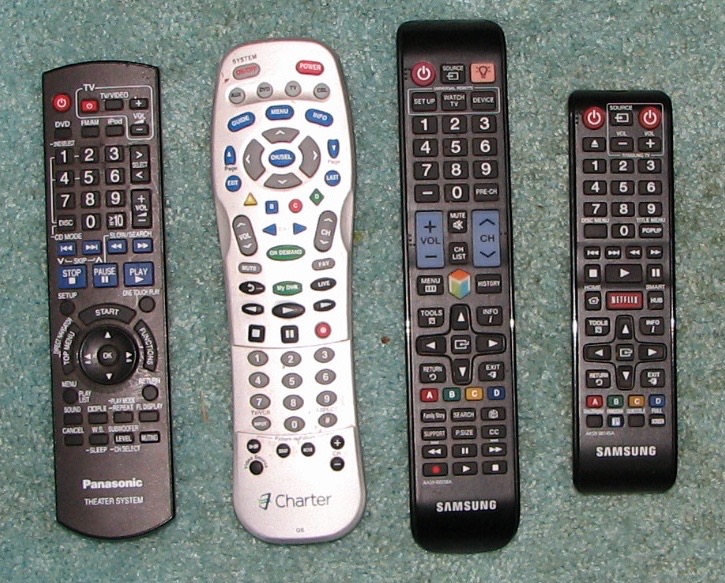Technology in general, and software in particular, has gotten too damn complicated. The central problem is obvious: it’s all designed for the aficionado, the “power user”, the person who intends to use it night and day. If you intend only to use the device or app on a less-than-professional level, you’re inundated with more features and controls than you can possibly handle. In this essay, I’ll add up the number of controls that I must learn to use in order to use the stuff that I use on a regular basis.
Television
When I was young, a television set had just three controls: On/Off; channel selector (a rotating switch); and sound volume. There might be some adjustment knobs on the back of the TV, but that was mostly for technicians.
Here are the controllers I now must use:

These four controllers boast a total of 206 buttons. Moreover, these buttons are not the only controls; many of the buttons serve different uses in different contexts. Sometimes these different functions are split ambiguously among different buttons. For example, when I want to play a recorded TV program, sometimes I must use the “play” button, and sometimes I must use the “OK/SEL” button. I have never figured out the means to discriminate them. Out of these 206 buttons, I use 14; I don’t think I have ever deliberately touched any of the other 192 buttons.
iPhone
Next comes my iPhone. To be fair, I will not include any of the apps that I downloaded; I will limit my count to only those built-in apps that I use often. These are: Calendar, Messages, Photos, Camera, Maps, Weather, Clock, Notes, Settings, FaceTime, Phone, Mail, Safari, and Music. And of course, there’s the iPhone “Finder”, the outer-level program that handles all the other apps. Let’s just start with the plethora of actions that count as verbs: tap, Home, Sleep/Wake, drag, flick, shake, and pinch. The difference between drag and flick is a matter of speed. There are also, of course, sequential combinations of just about every one of these. There are also verbs that rely on your starting at one edge of the screen and dragging in a particular direction.
I have searched the web and I have been unable to find any comprehensive list of commands available at the Finder level in iOS 7. There are tons of ‘tips & tricks’ articles, but nothing that attempts to present a complete list. Therefore, I must simply estimate the number of verbs available in each context. These are wild guesses, but they’re the best I can come up with:
“Finder”: 20
Calendar: 10
Messages: 5
Photos: 5
Camera: 5
Maps: 10
Weather: 2
Clock: 10
Notes: 10
Settings: 100
FaceTime: 5
Phone: 10
I have left out Mail and Safari because they are close to the Macintosh versions, so I’ll count them there. My estimates are obviously conservative; I have left out universal verbs such as cut, copy, past, OK, cancel, etc.
The total for the iPhone comes to ~200 verbs. And remember, that doesn’t include a lot of verbs that I seldom or never use.
Macintosh
This is my main computing device and for it I have a great many applications and uses. Here are the programs that I commonly use. I’m leaving out a number of programs that I use only occasionally. Also, I’m guessing the verb counts after looking at menus and dialog boxes.
Finder: 100
Safari: 50
Mail: 50
Pages: 100
System Preferences: 200
TextWrangler: 200
OmniGraffle: 200
Pixelmator: 200
iTunes: 50
Eclipse: 500
FaceTime: 10
Numbers: 300
Cyberduck: 100
Sandvox: 200
Keynote: 100
Java: 500
PHP: 40
HTML: 50
Macintosh Total: 2950 verbs. Let’s round it up to a nice, clean 3,000 verbs.
Implications
Adding up all three sources produces a grand total of 3,400 verbs. Now consider the implications of this: I am expected to learn the meanings of over 3,000 verbs in order to properly utilize my technology.
Compare this with the ancient Egyptian scribes, who had to memorize about 2,000 distinct hieroglyphs to practice their craft. A typical scribe underwent at least ten years of specialized training before he could practice his craft properly.
In other words, just using my computer requires me to learn more distinct items than a professional Egyptian scribe learned. This is simply too much. Here are some of the graphical expressions of some of the verbs in some of these applications:
Can you make sense out of any of these?
Conclusions
I think that the conclusion from all this should be obvious: we have reached the limits of the GUI system. The old command-line system had to be abandoned when its verb count exceeded about a hundred verbs; there were just too many commands for people to memorize. The GUI system permitted us to go much further, but we have now reached its upper limits. It is time to move on to another user interface system, and that system should be obvious to everybody: a linguistic user interface based on voice interaction. I shouldn’t have to figure out what all these weird symbols mean; I should be able to simply say “Print this” or “Play an episode of Gilligan’s Island” and be done with it. Apple has made the greatest strides forward with its Siri interface but it needs to take it much further. I think that Apple is being too conservative after the ugly experience they had with the handwriting recognition in the Newton back in the 1990s. I hope that they will push this new interface system hard.
Besides, that’s how they do it on Star Trek:

